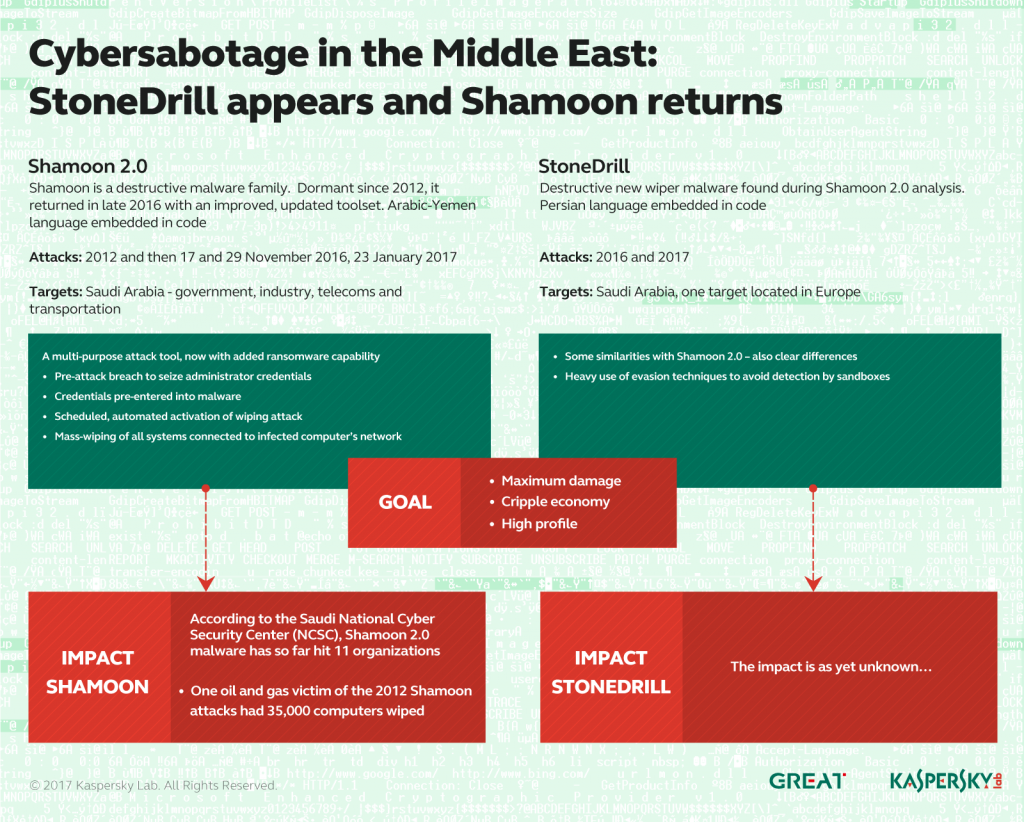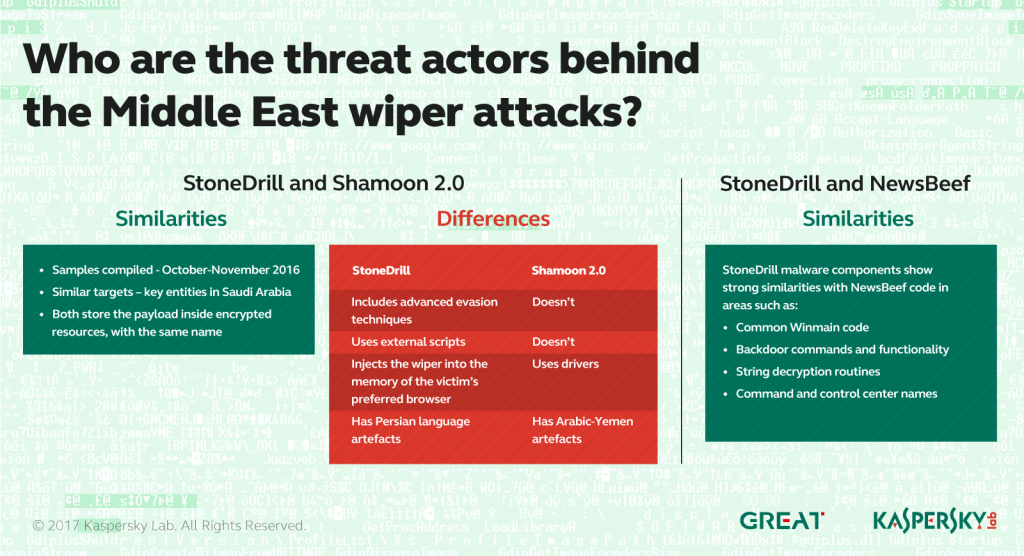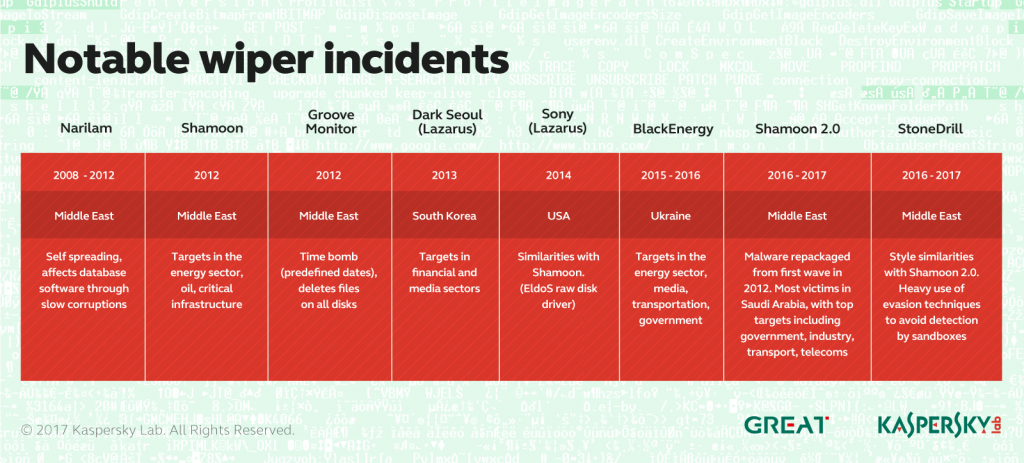
Wipers attacking Saudi organizations and beyond
Beginning in November 2016, Kaspersky Lab observed a new wave of wiper attacks directed at multiple targets in the Middle East. The malware used in the new attacks was a variant of the infamous Shamoon worm that targeted Saudi Aramco and Rasgas back in 2012.
Dormant for four years, one of the most mysterious wipers in history has returned.
So far, we have observed three waves of attacks of the Shamoon 2.0 malware, activated on 17 November 2016, 29 November 2016 and 23 January 2017.
Also known as Disttrack, Shamoon is a highly destructive malware family that effectively wipes the victim machine. A group known as the Cutting Sword of Justice took credit for the Saudi Aramco attack by posting a Pastebin message on the day of the attack (back in 2012), and justified the attack as a measure against the Saudi monarchy.
The Shamoon 2.0 attacks seen in November 2016 targeted organizations in various critical and economic sectors in Saudi Arabia. Just like the previous variant, the Shamoon 2.0 wiper aims for the mass destruction of systems inside compromised organizations.
The new attacks share many similarities with the 2012 wave and now feature new tools and techniques. During the first stage, the attackers obtain administrator credentials for the victim’s network. Next, they build a custom wiper (Shamoon 2.0) which leverages these credentials to spread widely inside the organization. Finally, on a predefined date, the wiper activates, rendering the infected machines completely inoperable. It should be noted that the final stages of the attacks are completely automated, without the need for communication with the command and control center.
While investigating the Shamoon 2.0 attacks, Kaspersky Lab also discovered a previously unknown wiper malware which appears to be targeting organizations in Saudi Arabia. We’re calling this new wiper StoneDrill. StoneDrill has several “style” similarities to Shamoon, with multiple interesting factors and techniques to allow for the better evasion of detection. In addition to suspected Saudi targets, one victim of StoneDrill was observed on the Kaspersky Security Network (KSN) in Europe. This makes us believe the threat actor behind StoneDrill is expanding its wiping operations from the Middle East to Europe.
To summarize some of the characteristics of the new wiper attacks, for both Shamoon and StoneDrill:
- Shamoon 2.0 includes a fully functional ransomware module, in addition to its common wiping functionality.
- Shamoon 2.0 has both 32-bit and 64-bit components.
- The Shamoon samples we analyzed in January 2017 do not implement any command and control (C&C) communication; previous ones included a basic C&C functionality that referenced local servers in the victim’s network.
- StoneDrill makes heavy use of evasion techniques to avoid sandbox execution.
- While Shamoon embeds Arabic-Yemen resource language sections, StoneDrill embeds mostly Persian resource language sections. Of course, we do not exclude the possibility of false flags.
- StoneDrill does not use drivers during deployment (unlike Shamoon) but relies on memory injection of the wiping module into the victim’s preferred browser.
- Several similarities exist between Shamoon and StoneDrill.
- Multiple similarities were found between StoneDrill and previously analysed NewsBeef attacks.
We are releasing a full technical report that provides new insights into the Shamoon 2.0 and StoneDrill attacks, including:
- The discovery techniques and strategies we used for Shamoon and StoneDrill.
- Details on the ransomware functionality found in Shamoon 2.0. This functionality is currently inactive but could be used in future attacks.
- Details on the newly found StoneDrill functions, including its destructive capabilities (even with limited user privileges).
- Details on the similarities between malware styles and malware components’ source code found in Shamoon, StoneDrill and NewsBeef.
Our discovery of StoneDrill provides another dimension to the existing wave of wiper attacks against Saudi organizations that started with Shamoon 2.0 in November 2016. Compared to the new Shamoon 2.0 variants, the most significant difference is the lack of a disk driver used for direct access during the destructive step. Nevertheless, one does not necessarily need raw disk access to perform destructive functions at file level, which the malware implements quite successfully.
Of course, one of the most important questions here is the connection between Shamoon and StoneDrill. Both wipers appear to have been used against Saudi organizations during a similar timeframe of October-November 2016. Several theories are possible here:
- StoneDrill is a less-used wiper tool, deployed in certain situations by the same Shamoon group.
- StoneDrill and Shamoon are used by different groups which are aligned in their interests.
- StoneDrill and Shamoon are used by two different groups which have no connection to each other and just happen to target Saudi organizations at the same time.
Taking all factors into account, our opinion is that the most likely theory is the second.
Additionally, StoneDrill appears to be connected with previously reported NewsBeef activity, which continues to target Saudi organizations. From this point of view, NewsBeef and StoneDrill appear to be continuously focused on targeting Saudi interests, while Shamoon is a flashy, come-and-go high impact tool.
In terms of attribution, while Shamoon embeds Arabic-Yemen resource language sections, StoneDrill embeds mostly Persian resource language sections. Geopolitical analysts would be quick to point out that Iran and Yemen are both players in the Iran-Saudi Arabia proxy conflict. Of course, we do not exclude the possibility of false flags.
Finally, many unanswered question remain in regards to StoneDrill and NewsBeef. The discovery of the StoneDrill wiper in Europe is a significant sign that the group is expanding its destructive attacks outside the Middle East. The target for the attack appears to be a large corporation with a wide area of activity in the petro-chemical sector, with no apparent connection or interest in Saudi Arabia.
As usual, we will continue to monitor the Shamoon, StoneDrill and NewsBeef attacks.
A presentation about StoneDrill will be given at the Kaspersky Security Analyst Summit Conference in April 2-6, 2017.
Kaspersky Lab products detect the Shamoon and StoneDrill samples as:
Trojan.Win32.EraseMBR.a
Trojan.Win32.Shamoon.a
Trojan.Win64.Shamoon.a
Trojan.Win64.Shamoon.b
Backdoor.Win32.RemoteConnection.d
Trojan.Win32.Inject.wmyv
Trojan.Win32.Inject.wmyt
HEUR:Trojan.Win32.Generic
Indicators of Compromise
Shamoon MD5s
00c417425a73db5a315d23fac8cb353f
271554cff73c3843b9282951f2ea7509
2cd0a5f1e9bcce6807e57ec8477d222a
33a63f09e0962313285c0f0fb654ae11
38f3bed2635857dc385c5d569bbc88ac
41f8cd9ac3fb6b1771177e5770537518
5446f46d89124462ae7aca4fce420423
548f6b23799f9265c01feefc6d86a5d3
63443027d7b30ef0582778f1c11f36f3
6a7bff614a1c2fd2901a5bd1d878be59
6bebb161bc45080200a204f0a1d6fc08
7772ce23c23f28596145656855fd02fc
7946788b175e299415ad9059da03b1b2
7edd88dd4511a7d5bcb91f2ff177d29d
7f399a3362c4a33b5a58e94b8631a3d5
8405aa3d86a22301ae62057d818b6b68
8712cea8b5e3ce0073330fd425d34416
8fbe990c2d493f58a2afa2b746e49c86
940cee0d5985960b4ed265a859a7c169
9d40d04d64f26a30da893b7a30da04eb
aae531a922d9cca9ddca3d98be09f9df
ac8636b6ad8f946e1d756cd4b1ed866d
af053352fe1a02ba8010ec7524670ed9
b4ddab362a20578dc6ca0bc8cc8ab986
baa9862b027abd61b3e19941e40b1b2d
c843046e54b755ec63ccb09d0a689674
d30cfa003ebfcd4d7c659a73a8dce11e
da3d900f8b090c705e8256e1193a18ec
dc79867623b7929fd055d94456be8ba0
ec010868e3e4c47239bf720738e058e3
efab909e4d089b8f5a73e0b363f471c1
StoneDrill MD5s
ac3c25534c076623192b9381f926ba0d
0ccc9ec82f1d44c243329014b82d3125
8e67f4c98754a2373a49eaf53425d79a
fb21f3cea1aa051ba2a45e75d46b98b8
StoneDrill C2s
www.eservic[.]com
www.securityupdated[.]com
www.actdire[.]com
www.chromup[.]com
NewsBeef C2s
www.chrome-up[.]date
service1.chrome-up[.]date
service.chrome-up[.]date
webmaster.serveirc[.]com
From Shamoon to StoneDrill
























Neal Dennis
Can y’all share, even if offline, the one Euro connection?
A Lis
Great report, thanks for sharing.